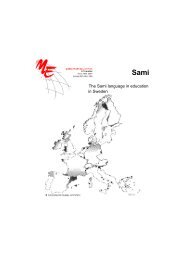Multilingual Early Language Transmission (MELT) - Mercator ...
Multilingual Early Language Transmission (MELT) - Mercator ...
Multilingual Early Language Transmission (MELT) - Mercator ...
You also want an ePaper? Increase the reach of your titles
YUMPU automatically turns print PDFs into web optimized ePapers that Google loves.
in chapter 4, have demonstrated that when parents and pre-school practitioners consistently<br />
speak the minority language to children, this will ultimately lead to better results in the<br />
majority language as well; the level of development of children’s mother tongue is a strong<br />
predictor of their second or third language development. The promotion and stimulation of<br />
smaller state and regional & minority languages from an early age is crucial to the overall<br />
development of the child, i.e. its becoming a permanently multilingual individual, particularly<br />
in an era of ever-increasing globalisation. The <strong>MELT</strong> project explicitly stresses that the<br />
acquisition of the minority language at an early age is favourable to the development of the<br />
multilingual individual.<br />
Nevertheless, to become a multilingual individual, some conditions will have to be met: the<br />
child must feel the need to communicate and to interact with others and to speak more<br />
languages; different factors such as language input and a positive language attitude in the<br />
social environment must be present; the child should have a natural development; the<br />
parents should choose a ‘fitting’ language strategy of immersion. When these conditions are<br />
met, the child is in a position to grow up multilingually. To continue as a multilingual<br />
individual, it is not only important that there be a balance between all conditions, but also<br />
that they are fulfilled during the different developmental stages (infant, toddler, school<br />
child, adolescent and young adult etc.). When continued attention is paid to all conditions,<br />
we may speak of a “continuous multilingual development” in which the child may hopefully<br />
develop into a multilingual individual. The model of continuous multilingual development is<br />
presented in chapter 4.4.<br />
Chapter 5 contains recommendations for materials and resources in pre-school. During the<br />
implementation process of the Guide in the four regions, the tutors experienced that<br />
immersion and language acquisition was most successful when pre-school practitioners<br />
offered the children a rich and varied input in the minority language. In general, however,<br />
pre-school practitioners need confidence and guidance in developing the correct skills and<br />
expertise necessary for the creation of an environment and the implementation of activities<br />
that will promote the child’s language development.<br />
In chapter 6 recommendations and future challenges are formulated, directed at local and<br />
regional authorities as well as national governments and European organisations. The overall<br />
goal of these recommendations and challenges is the strengthening of the relationship<br />
between theory and practice with respect to the multilingual upbringing of children.<br />
The publication is augmented by three contributions on special themes regarding language<br />
learning and training of practitioners, written by international experts.<br />
5



